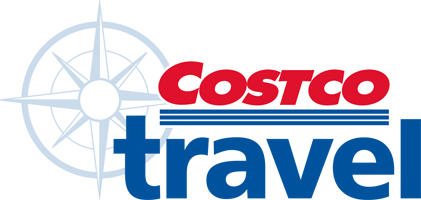
Europe and Mediterranean: Baltic & Scandinavian Capitals Cruise
Holland America Line
Experience the countless charms of Sweden, Denmark, Germany and others on a roundtrip cruise from Rotterdam. Scenic cruise Oslofjord and winding canals. During an overnight stay in Stockholm, go sightseeing in elegant Östermalm; explore museums in Djurgården; roam ancient Gamla Stan with its cobbled streets that surround the Royal Palace; and trendy Södermalm.

Executive Member Benefit
Executive Members receive an annual 2% Reward, up to $1,250, on qualified Costco Travel purchases
Digital Costco Shop Card
Member Exclusive: Digital Costco Shop Card with every Holland America Line sailing†
Onboard the Rotterdam
Rotterdam
Year Built: 2020
In honor of some of the most memorable ships in Holland America Line's history, their third Pinnacle-class ship (and new flagship) will be named Rotterdam. This new addition to the fleet will fill your journey with a rhythm all its own, putting music front and center, creating the soundtrack to the discoveries you make every day. At the heart of it all is Music Walk®: an exclusive collection of five venues featuring live music and electrifying performances from accomplished musicians, dancers and artists every night. Rotterdam hits all the right notes: exquisite dining experiences, enhanced staterooms and suites, the finest service at sea and craftsmanship that reflects nearly 150 years of seafaring expertise. The result is a ship that moves you — from the start of your first day to the end of each perfect night. Ship images are an artist rendering.
Activities & Services (included in cruise)
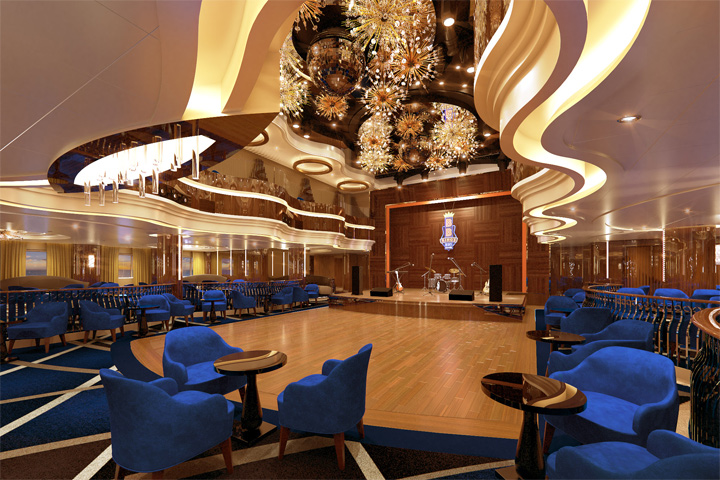
BB King's Blues Club
- Casino
- Disco/Nightclub
- Game Arcade
- Movies
- Theater/Show Lounge
- Fitness Center
- Pool - Outdoor
- Pool - Indoor/Covered
- Sports Facilities
- Whirlpool/Jacuzzi
- Bars/Lounges
- Internet Center
- Library
- Billboard Onboard
- Rolling Stone Rock Room
- B.B. Kings Blues Club
- Organized Age Specific Activities
- Concierge Desk
- Elevators
- Safe Deposit Boxes
Activities & Services (available for an extra fee)

Greenhouse Spa
- Beauty Salon
- Fitness Classes
- Full-Service Spa
- Spa Services/Massage
- Duty-Free Shops/Boutiques
- Infirmary/Medical Center
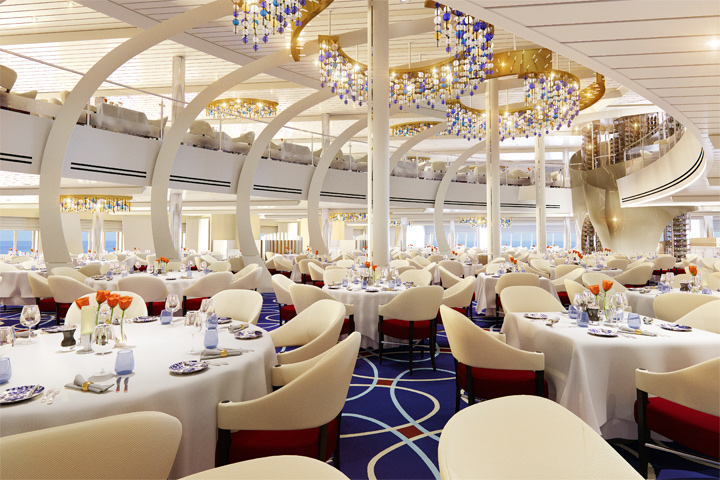
Dining Room
Main Dining
Dining Room: For breakfast, lunch or an unforgettable five-course dinner, the elegant main Dining Room is your destination for sophisticated dining, with menu selections from classic favorites to vegetarian options to dishes inspired by the regions you’ll visit.
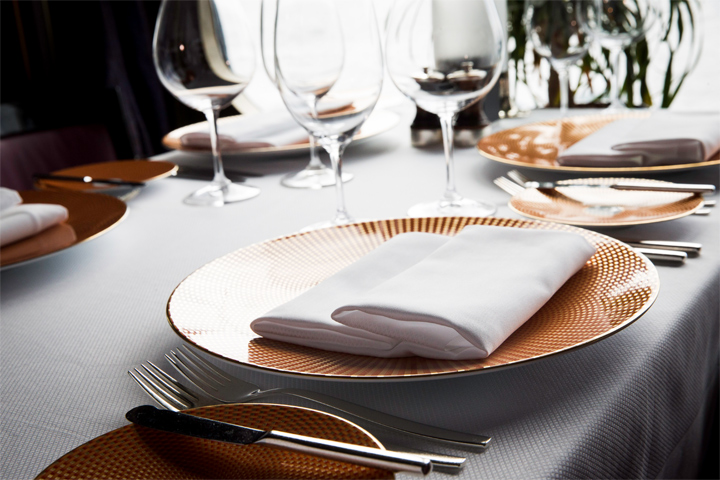
Pinnacle Grill
Specialty Dining
Pinnacle Grill: Reserve a table in the intimate Pinnacle Grill for lunch or dinner and celebrate the day’s adventures with cuisine inspired by the bounty of America’s Pacific Northwest. In this elegantly appointed room, service is warm and engaging, and a meal is an event. The menu focuses on premium ingredients expertly prepared—from wild-caught king salmon from Alaska to sustainably raised beef from Washington State’s Double R Ranch. And, every evening in this venue offers a chance for you to experience the signature recipes of Culinary Council Chef David Burke. Complementing your perfectly prepared meals are boutique wines from the Pacific Northwest and other celebrated vineyards from around the world. This restaurant is available for an additional cost.
Canaletto: This authentic Italian restaurant offers a menu that celebrates spartire (Italian for "sharing"). Try Braised Chicken Cacciatore "al Forno" Branzino ai Ferri or a classic Italian pasta: spaghetti pomodoro or garlic shrimp-infused ravioli, perhaps. Buon appetito! This restaurant is available for an additional cost.
Rudi's Sel De Mer: Named for Master Chef Rudi Sodamin, Rudi’s Sel de Mer is an intimate brasserie featuring classic French dishes reimagined with contemporary flair. Menu selections include whole Dover sole meunière with shaved pink Himalayan sea salt, oysters on the half shell, fruits de mer, and salt-crust baked branzino, as well as favorites such as steak frites, duck cassoulet and coq au vin. Conclude your dinner with a classic dessert and fine French cheeses. This restaurant is available for an additional cost.
Tamarind: Tamarind delights with exotic menus evoking the culinary traditions of Southeast Asia, China and Japan. Menus created by Master Chef Rudi Sodamin feature dishes honoring the elements of water, wood, fire and earth. This restaurant is available for an additional cost.
Nami Sushi: Inspired by Culinary Council® member and world-renowned sushi master, Andy Matsuda, Nami Sushi offers a tempting array of the sushi rolls he’s created. Choose from such delectable selections as Tempura Lobster Roll with soft shell crab tempura; Dragon Roll with tempura shrimp, unagi sauce and avocado; Tsutsumi Roll with snapper, green olive, caper and avocado; Futomoki Roll with crab, yamagobo, avocado and cucumber; Volcano Roll with sesame-marinated salmon and Thai chilis; Nigiri sushi with tuna, salmon and ebi shrimp; and more. The word “nami”, Japanese in origin, means “wave” and is a homage to the ocean views you’ll enjoy as you dine on the freshest, tastiest and most inventive sushi at sea. This restaurant is available for an additional cost.
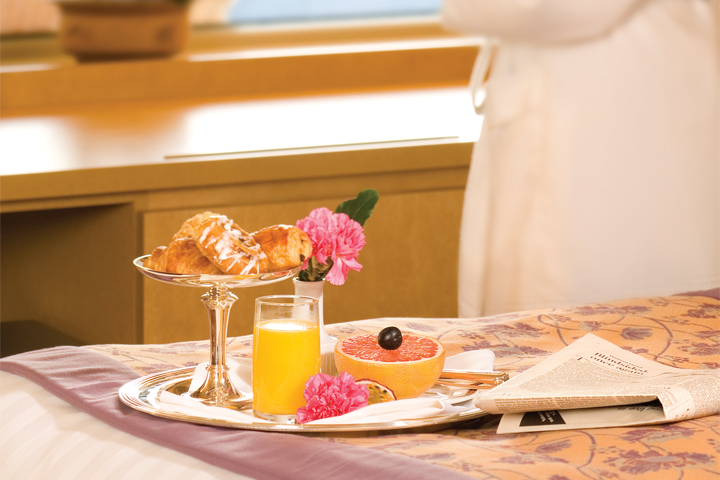
Room Service
Casual Dining
Lido Market: Explore a world of intriguing culinary possibilities in the Lido Market. Steps from the Lido pool, this modern marketplace includes a curated selection of delicious options that you can grab on the go or have made to order: Breadboard, with freshly baked breads and pastries; Wild Harvest, offering a bountiful selection of hearty salads; Homestead, serving up comfort classics; Distant Lands, featuring global cuisine; Sweet Spot, for ice cream creations and desserts; Roasting Pan, hand-carved meats, fish and other hearty entrees; Perk, freshly brewed beverages and chilled juices; Quench, premium coffee, beer, wine, and soda available for purchase; Rise, savory quiches, croissants and sandwiches, and more.
New York Deli and Pizza: Authentic deli sandwiches piled high, indulgent personal pan pizzas and creative salads are served up poolside.
Grand Dutch Café: Inspired by blue and white Delftware, the Grand Dutch Cafe is the place to enjoy a fine pale lager or favorite coffee beverage with a traditional Dutch snack. This restaurant is available for an additional cost.
Gelato: At Gelato, you can indulge your sweet tooth with a classic European gelato (ice cream), made fresh on board each day by chefs trained at the Carpigiani Gelato University. Choose among 12 delightful flavors, two of which are rotated daily. This restaurant is available for an additional cost.
Room Service: Complimentary 24-hour dining in the comfort of your stateroom.
Elegant staterooms feature luxurious bedding, premium massage showerheads and more.
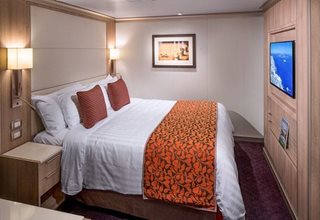
Category: IQ
Amenities- Daily housekeeping
- Complimentary 24-hour room service
- Elemis Aromapure soap, lotion, shampoo
- Luxurious bathrobes
- Generous storage
- Fresh fruit upon request
- Safe
- Shoeshine
- TV with On Demand movies, programming

Category: I
Amenities- Daily housekeeping
- Complimentary 24-hour room service
- Elemis Aromapure soap, lotion, shampoo
- Luxurious bathrobes
- Generous storage
- Fresh fruit upon request
- Safe
- Shoeshine
- TV with On Demand movies, programming

Category: J
Amenities- Daily housekeeping
- Complimentary 24-hour room service
- Elemis Aromapure soap, lotion, shampoo
- Luxurious bathrobes
- Generous storage
- Fresh fruit upon request
- Safe
- Shoeshine
- TV with On Demand movies, programming

Category: K
Amenities- Daily housekeeping
- Complimentary 24-hour room service
- Elemis Aromapure soap, lotion, shampoo
- Luxurious bathrobes
- Generous storage
- Fresh fruit upon request
- Safe
- Shoeshine
- TV with On Demand movies, programming

Category: L
Amenities- Daily housekeeping
- Complimentary 24-hour room service
- Elemis Aromapure soap, lotion, shampoo
- Luxurious bathrobes
- Generous storage
- Fresh fruit upon request
- Safe
- Shoeshine
- TV with On Demand movies, programming

Category: N
Amenities- Daily housekeeping
- Complimentary 24-hour room service
- Elemis Aromapure soap, lotion, shampoo
- Luxurious bathrobes
- Generous storage
- Fresh fruit upon request
- Safe
- Shoeshine
- TV with On Demand movies, programming
Elegant staterooms feature luxurious bedding, premium massage showerheads and a porthole or a window. All VH-category staterooms have partially obstructed views.
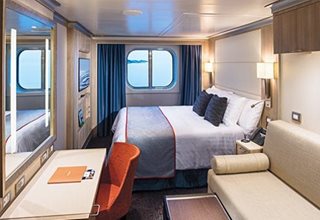
Category: FA
Amenities- Daily housekeeping
- Complimentary 24-hour room service
- Elemis Aromapure soap, lotion, shampoo
- Luxurious bathrobes
- Hair dryers, makeup mirrors
- Fresh fruit upon request
- Safe
- Ice service
- Shoeshine
- TV with On Demand movies, programming

Category: FB
Amenities- Daily housekeeping
- Complimentary 24-hour room service
- Elemis Aromapure soap, lotion, shampoo
- Luxurious bathrobes
- Hair dryers, makeup mirrors
- Fresh fruit upon request
- Safe
- Ice service
- Shoeshine
- TV with On Demand movies, programming
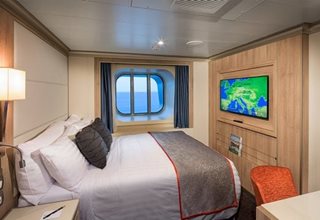
Category: CQ
Amenities- Daily housekeeping
- Complimentary 24-hour room service
- Elemis Aromapure soap, lotion, shampoo
- Luxurious bathrobes
- Hair dryers, makeup mirrors
- Fresh fruit upon request
- Safe
- Ice service
- Shoeshine
- TV with On Demand movies, programming
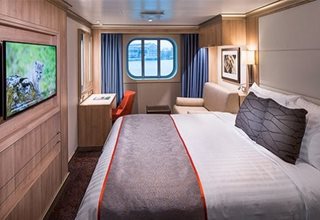
Category: C
Amenities- Daily housekeeping
- Complimentary 24-hour room service
- Elemis Aromapure soap, lotion, shampoo
- Luxurious bathrobes
- Hair dryers, makeup mirrors
- Fresh fruit upon request
- Safe
- Ice service
- Shoeshine
- TV with On Demand movies, programming

Category: D
Amenities- Daily housekeeping
- Complimentary 24-hour room service
- Elemis Aromapure soap, lotion, shampoo
- Luxurious bathrobes
- Hair dryers, makeup mirrors
- Fresh fruit upon request
- Safe
- Ice service
- Shoeshine
- TV with On Demand movies, programming

Category: E
Amenities- Daily housekeeping
- Complimentary 24-hour room service
- Elemis Aromapure soap, lotion, shampoo
- Luxurious bathrobes
- Hair dryers, makeup mirrors
- Fresh fruit upon request
- Safe
- Ice service
- Shoeshine
- TV with On Demand movies, programming

Category: F
Amenities- Daily housekeeping
- Complimentary 24-hour room service
- Elemis Aromapure soap, lotion, shampoo
- Luxurious bathrobes
- Hair dryers, makeup mirrors
- Fresh fruit upon request
- Safe
- Ice service
- Shoeshine
- TV with On Demand movies, programming

Category: OO
Amenities- Daily housekeeping
- Complimentary 24-hour room service
- Elemis Aromapure soap, lotion, shampoo
- Luxurious bathrobes
- Hair dryers, makeup mirrors
- Fresh fruit upon request
- Safe
- Ice service
- Shoeshine
- TV with On Demand movies, programming
Elegant staterooms feature luxurious bedding, premium massage showerheads and floor-to-ceiling windows overlooking a private verandah.

Category: VQ
Amenities- Daily housekeeping
- Complimentary 24-hour room service
- Elemis Aromapure soap, lotion, shampoo
- Luxurious bathrobes
- Hair dryers, makeup mirrors
- Fresh fruit upon request
- Safe
- Ice service
- Shoeshine
- TV with On Demand movies, programming

Category: VS
Amenities- Daily housekeeping
- Complimentary 24-hour room service
- Elemis Aromapure soap, lotion, shampoo
- Luxurious bathrobes
- Hair dryers, makeup mirrors
- Fresh fruit upon request
- Safe
- Ice service
- Shoeshine
- TV with On Demand movies, programming

Category: V
Amenities- Daily housekeeping
- Complimentary 24-hour room service
- Elemis Aromapure soap, lotion, shampoo
- Luxurious bathrobes
- Hair dryers, makeup mirrors
- Fresh fruit upon request
- Safe
- Ice service
- Shoeshine
- TV with On Demand movies, programming

Category: VA
Amenities- Daily housekeeping
- Complimentary 24-hour room service
- Elemis Aromapure soap, lotion, shampoo
- Luxurious bathrobes
- Hair dryers, makeup mirrors
- Fresh fruit upon request
- Safe
- Ice service
- Shoeshine
- TV with On Demand movies, programming

Category: VB
Amenities- Daily housekeeping
- Complimentary 24-hour room service
- Elemis Aromapure soap, lotion, shampoo
- Luxurious bathrobes
- Hair dryers, makeup mirrors
- Fresh fruit upon request
- Safe
- Ice service
- Shoeshine
- TV with On Demand movies, programming

Category: VC
Amenities- Daily housekeeping
- Complimentary 24-hour room service
- Elemis Aromapure soap, lotion, shampoo
- Luxurious bathrobes
- Hair dryers, makeup mirrors
- Fresh fruit upon request
- Safe
- Ice service
- Shoeshine
- TV with On Demand movies, programming

Category: VD
Amenities- Daily housekeeping
- Complimentary 24-hour room service
- Elemis Aromapure soap, lotion, shampoo
- Luxurious bathrobes
- Hair dryers, makeup mirrors
- Fresh fruit upon request
- Safe
- Ice service
- Shoeshine
- TV with On Demand movies, programming

Category: VE
Amenities- Daily housekeeping
- Complimentary 24-hour room service
- Elemis Aromapure soap, lotion, shampoo
- Luxurious bathrobes
- Hair dryers, makeup mirrors
- Fresh fruit upon request
- Safe
- Ice service
- Shoeshine
- TV with On Demand movies, programming

Category: VF
Amenities- Daily housekeeping
- Complimentary 24-hour room service
- Elemis Aromapure soap, lotion, shampoo
- Luxurious bathrobes
- Hair dryers, makeup mirrors
- Fresh fruit upon request
- Safe
- Ice service
- Shoeshine
- TV with On Demand movies, programming

Category: VH
Amenities- Daily housekeeping
- Complimentary 24-hour room service
- Elemis Aromapure soap, lotion, shampoo
- Luxurious bathrobes
- Hair dryers, makeup mirrors
- Fresh fruit upon request
- Safe
- Ice service
- Shoeshine
- TV with On Demand movies, programming
Luxurious suites feature a whirlpool bath (some with shower only), large sitting area, private balcony, floor-to-ceiling windows and more.
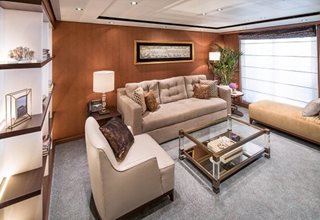
Category: PS
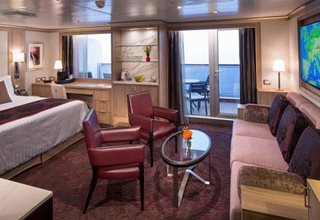
Category: SQ
Amenities- Daily housekeeping
- Complimentary 24-hour room service
- Elemis Aromapure soap, lotion, shampoo
- Premium bathrobes, slippers
- Hair dryers, makeup mirrors
- Fresh fruit upon request
- Safe
- Ice service
- Shoeshine
- TV with On Demand movies, programming
- Fresh flowers
- One-Touch concierge service
- Whirlpool bath (suite dependent)
- In-suite coffee, espresso
- Complimentary laundry
- Pre-dinner hors d'oeuvres served in suite
- Welcome glass of sparkling wine
- Priority boarding for tender ports, priority dining/seating requests, special disembarkation service
- High tea in suite on request
- Binoculars
- Exclusive tote bag

Category: SA
Amenities- Daily housekeeping
- Complimentary 24-hour room service
- Elemis Aromapure soap, lotion, shampoo
- Premium bathrobes, slippers
- Hair dryers, makeup mirrors
- Fresh fruit upon request
- Safe
- Ice service
- Shoeshine
- TV with On Demand movies, programming
- Fresh flowers
- One-Touch concierge service
- Whirlpool bath (suite dependent)
- In-suite coffee, espresso
- Complimentary laundry
- Pre-dinner hors d'oeuvres served in suite
- Welcome glass of sparkling wine
- Priority boarding for tender ports, priority dining/seating requests, special disembarkation service
- High tea in suite on request
- Binoculars
- Exclusive tote bag

Category: SB
Amenities- Daily housekeeping
- Complimentary 24-hour room service
- Elemis Aromapure soap, lotion, shampoo
- Premium bathrobes, slippers
- Hair dryers, makeup mirrors
- Fresh fruit upon request
- Safe
- Ice service
- Shoeshine
- TV with On Demand movies, programming
- Fresh flowers
- One-Touch concierge service
- Whirlpool bath (suite dependent)
- In-suite coffee, espresso
- Complimentary laundry
- Pre-dinner hors d'oeuvres served in suite
- Welcome glass of sparkling wine
- Priority boarding for tender ports, priority dining/seating requests, special disembarkation service
- High tea in suite on request
- Binoculars
- Exclusive tote bag

Category: SC
Amenities- Daily housekeeping
- Complimentary 24-hour room service
- Elemis Aromapure soap, lotion, shampoo
- Premium bathrobes, slippers
- Hair dryers, makeup mirrors
- Fresh fruit upon request
- Safe
- Ice service
- Shoeshine
- TV with On Demand movies, programming
- Fresh flowers
- One-Touch concierge service
- Whirlpool bath (suite dependent)
- In-suite coffee, espresso
- Complimentary laundry
- Pre-dinner hors d'oeuvres served in suite
- Welcome glass of sparkling wine
- Priority boarding for tender ports, priority dining/seating requests, special disembarkation service
- High tea in suite on request
- Binoculars
- Exclusive tote bag
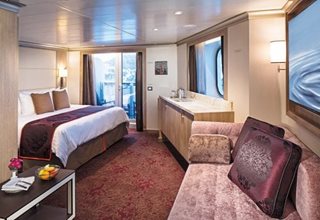
Category: SS
Amenities- Daily housekeeping
- Complimentary 24-hour room service
- Elemis Aromapure soap, lotion, shampoo
- Luxurious bathrobes
- Hair dryers, makeup mirrors
- Generous storage
- Fresh fruit upon request
- Safe
- Ice service
- Shoeshine
- TV with On Demand movies, programming
- Binoculars

Category: SY
Amenities- Daily housekeeping
- Complimentary 24-hour room service
- Elemis Aromapure soap, lotion, shampoo
- Luxurious bathrobes
- Hair dryers, makeup mirrors
- Generous storage
- Fresh fruit upon request
- Safe
- Ice service
- Shoeshine
- TV with On Demand movies, programming
- Binoculars

Category: AS
Amenities- Daily housekeeping
- Complimentary 24-hour room service
- Elemis Aromapure soap, lotion, shampoo
- Luxurious bathrobes
- Hair dryers, makeup mirrors
- Generous storage
- Fresh fruit upon request
- Safe
- Ice service
- Shoeshine
- TV with On Demand movies, programming
- Binoculars

Category: A
Amenities- Daily housekeeping
- Complimentary 24-hour room service
- Elemis Aromapure soap, lotion, shampoo
- Luxurious bathrobes
- Hair dryers, makeup mirrors
- Generous storage
- Fresh fruit upon request
- Safe
- Ice service
- Shoeshine
- TV with On Demand movies, programming
- Binoculars

Category: B
Amenities- Daily housekeeping
- Complimentary 24-hour room service
- Elemis Aromapure soap, lotion, shampoo
- Luxurious bathrobes
- Hair dryers, makeup mirrors
- Generous storage
- Fresh fruit upon request
- Safe
- Ice service
- Shoeshine
- TV with On Demand movies, programming
- Binoculars

Category: BC
Amenities- Daily housekeeping
- Complimentary 24-hour room service
- Elemis Aromapure soap, lotion, shampoo
- Luxurious bathrobes
- Hair dryers, makeup mirrors
- Generous storage
- Fresh fruit upon request
- Safe
- Ice service
- Shoeshine
- TV with On Demand movies, programming
- Binoculars
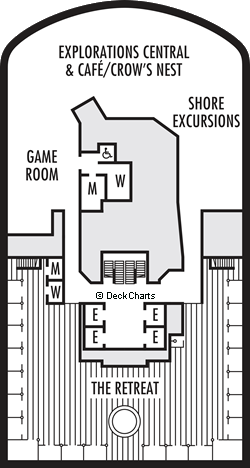
| Symbol | Description |
|---|---|
 | Quad (2 lower beds, 1 sofa bed, 1 upper) |
 | Triple (2 lower beds, 1 upper) |
 | Triple (2 lower beds, 1 sofa bed) |
 | Double (2 lower beds convertible to 1 king-size bed, no Murphy bed) |
 | Partially obstructed view |
 | Connecting rooms |
 | Floor-to-ceiling windows |
 | Shower only |
 | Uncovered verandah |
 | Solid steel verandah railing instead of clear-view plexiglass railing |
 | Fully accessible, roll-in shower only |
 | Ambulatory accessible, shower only with small step, step into bathroom, standard interior and exterior door size |
 | Part solid steel, part clear-view plexiglass railing |
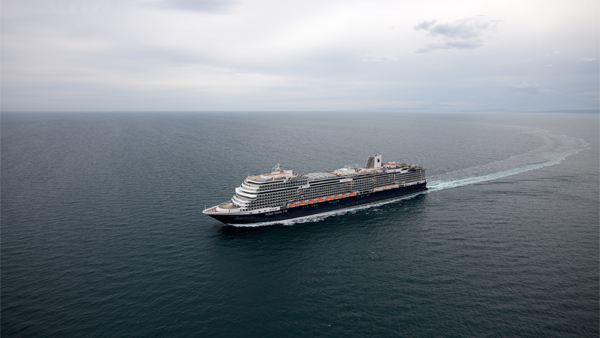
- Ship Name: Rotterdam
- Year Built: 2020
- Year Entered Present Fleet: 2021
- Ship Class: Pinnacle
- Maximum Capacity: 3,170
- Number of Passenger Decks: 13
- Number of Crew: 1,036
- Officers' Nationality: International
- Ocean-View without Balcony: 103
- Ocean-View with Balcony: 748
- Total Inside Staterooms: 280
- Tonnage (GRT): 99,500
- Country of Registry: Netherlands
- Total Staterooms: 1,339
- Suites with Balcony: 164
- Crew/Hotel Staff Nationality: International
Costco Member Reviews

*Price shown is per person based on double occupancy and is valid for select stateroom categories only. Click on the Terms & Conditions link below for details.
†One Digital Costco Shop Card per room/stateroom, per stay. The exact amount of the Digital Costco Shop Card will be calculated during the booking process. The Digital Costco Shop Card promotion is nontransferable and may not be combined with any other promotion. A Digital Costco Shop Card will arrive by email approximately 10 days after the start of your cruise. Click on the Terms & Conditions link below for additional information.
Ship's registry: The Netherlands
Digital Costco Shop Card
Book this vacation or cruise with Costco Travel and receive a Digital Costco Shop Card. The Digital Costco Shop Card is a convenient payment option in our warehouses and on Costco.com.

